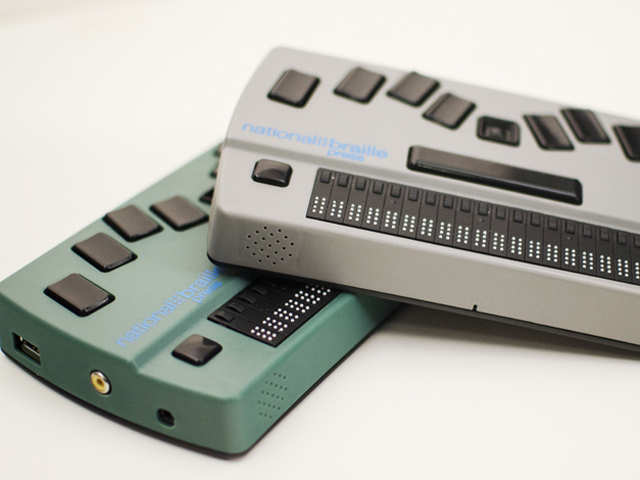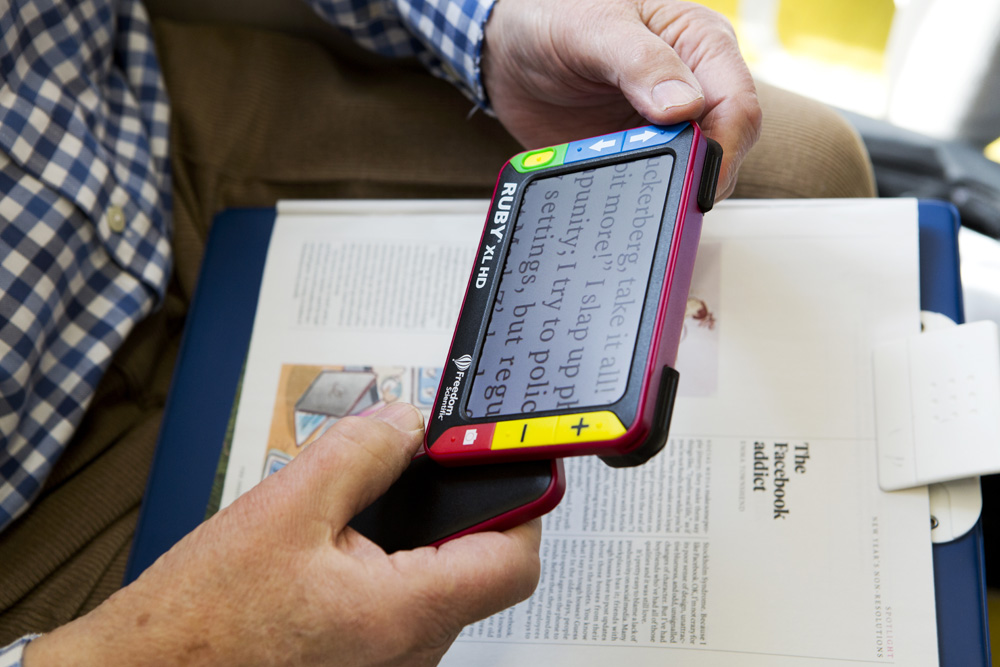AI-Powered Visual Aids: Enhancing Independence for Blind Users
Discover Cutting-edge Devices Created for the Visually Damaged
The growth of cutting-edge tools for the aesthetically impaired represents a considerable advancement in ease of access and independence. Technologies such as smart glasses with AI capabilities and mobile applications designed to supply acoustic descriptions are improving day-to-day experiences for users. Additionally, wearable gadgets that use haptic feedback improve environmental awareness, while contemporary Braille innovations offer brand-new methods to engage with text. As these devices continue to progress, their impact on the lives of those with visual disabilities increases important concerns regarding the future of inclusivity and freedom in different aspects of life. What lies in advance in this technological landscape?
Smart Glasses for Navigation

Smart glasses designed for navigating are revolutionizing the means aesthetically impaired people engage with their atmosphere. These advanced gadgets utilize a mix of cam innovation, expert system, and auditory responses to give real-time details about surroundings. By utilizing barrier detection systems, smart glasses can alert individuals to potential risks, allowing much safer wheelchair in both unfamiliar and acquainted settings.
The assimilation of GPS modern technology additionally enhances navigating capabilities, permitting individuals to receive acoustic instructions as they move. This hands-free strategy not only cultivates freedom however additionally empowers aesthetically impaired people to browse urban landscapes with boosted confidence. Additionally, lots of wise glasses are equipped with functions that identify spots and street indications, providing contextual info that improves the customer experience.
Furthermore, the growth of these devices is continuously progressing, with firms working to boost the accuracy of item acknowledgment and expand the variety of navigational attributes. As smart glasses end up being much more accessible and inexpensive, they hold the prospective to substantially transform life for aesthetically impaired users. Eventually, these cutting-edge tools stand for an important action towards inclusivity, offering boosted mobility and a greater sense of autonomy for people browsing the world around them.

Mobile Application for Daily Living
Just how can mobile applications enhance the day-to-days live of aesthetically damaged people? Mobile applications are transforming the way aesthetically impaired users navigate their environments, take care of day-to-day tasks, and access details. These applications provide vital assistance with various functionalities, cultivating self-reliance and improving lifestyle.
Numerous cutting-edge mobile applications are developed especially for everyday living. For instance, applications like Be My Eyes connect aesthetically damaged users with sighted volunteers by means of video telephone calls, enabling them to obtain real-time aid with tasks such as reviewing labels or browsing unfamiliar rooms. In A Similar Way, Seeing AI, created by Microsoft, utilizes synthetic intelligence to explain surroundings, checked out message, and identify things, effectively transforming a smart device into a powerful device for daily aid.
In addition, navigation apps tailored for the aesthetically damaged, such as Aira and BlindSquare, offer audio-based directions and environmental details, allowing customers to traverse their surroundings safely and with confidence. Past navigating and instant aid, mobile applications also sustain organization and task management, with features that aid users establish reminders, create to-do listings, and track consultations. In recap, mobile applications function as crucial resources, empowering visually impaired individuals to lead more independent and satisfying lives.
Wearable Technologies for Assistance
Empowerment via technology is progressively obvious in the world of wearable gadgets designed to help aesthetically damaged people. These cutting-edge devices integrate effortlessly right into day-to-day live, boosting navigating and providing important comments to users. For instance, wise glasses furnished with video cameras can read and recognize faces message out loud, enabling customers to communicate even more with confidence in social and expert settings.
An additional remarkable innovation is making use of haptic responses systems in wearable gadgets. These systems make use of resonances or other tactile signals to share info about the customer's setting, such as obstacles or changes in surface, enhancing movement and safety. Wearable modern technologies likewise include wristbands that connect to smart devices, signaling individuals to notifications via refined vibrations, thus boosting connectivity without dependence on visual cues.
As these modern technologies continue to develop, they are not just boosting self-reliance for visually damaged individuals yet also cultivating a higher feeling of addition in culture. By bridging the void between challenges faced in day-to-day living and the potential for autonomy, wearable modern technologies serve as crucial tools in the pursuit for equality and empowerment for those with aesthetic impairments.
Audio Description Tools
Sound description devices play an essential duty in enhancing access for visually damaged people, supplying them with the ability to engage with aesthetic media. Speech-to-text devices for low vision. These tools offer narrated summaries of key aesthetic components in films, television programs, and live efficiencies, making sure that users can completely comprehend the context and emotions communicated with visuals
Sound summary can be integrated into different systems, consisting of streaming services, cinema screenings, and live movie theater. Numerous prominent streaming solutions currently consist of audio summary as an ease of access function, enabling audiences to choose it quickly. In enhancement to conventional media, specialized applications additionally exist, giving audio descriptions for art exhibitions, galleries, and various other social occasions.
The performance of audio description hinges on the skill of the storytellers, that have to share aesthetic no line bifocal reading glasses information succinctly without diminishing the original audio. Innovations in this field are likewise leading the way for more customized experiences, where users can adjust the level of detail and pacing according to their preferences.
Braille Innovations and Devices
Braille tools and technologies have dramatically transformed the method visually damaged individuals communicate with message and information. Modern improvements have actually led to the advancement of flexible devices that improve literacy and self-reliance amongst users. Significantly, Braille present innovations have actually evolved, enabling dynamic reading experiences. These devices convert electronic text right into Braille, making it possible for individuals to access a large variety of details on smartphones, tablets, and computers.
Additionally, mobile Braille notetakers integrate conventional Braille input with contemporary capabilities, promoting note-taking, organizing, and paper editing and enhancing on the move. Speech-to-text devices for low vision. These small gadgets typically include text-to-speech abilities, connecting the space in between Braille click here for info and auditory information
Additionally, cutting-edge Braille printers have emerged, allowing customers to produce Braille labels, records, and instructional materials efficiently. This access promotes higher participation in instructional and professional environments, inevitably promoting inclusivity.
Furthermore, study right into clever Braille modern technologies remains to increase. Gadgets that incorporate synthetic knowledge are being explored to provide real-time navigating help and contextual details, improving the user experience in varied setups. Overall, these innovations show a commitment to encouraging aesthetically impaired people with modern technology, ensuring they can quickly accessibility and engage with the globe around them.

Verdict
The development of ingenious devices for the aesthetically damaged dramatically boosts freedom and quality of life. Smart glasses, mobile applications, wearable innovations, audio summary devices, and Braille innovations collectively equip individuals by offering vital navigation assistance, environmental recognition, and improved reading experiences. These innovations not only foster better inclusion yet additionally promote autonomy in day-to-day activities, inevitably adding to a much more fair and available society for aesthetically damaged people. Continued development in this field holds guarantee for further enhancements.
As smart glasses become more obtainable and budget-friendly, they hold the potential to substantially transform day-to-day life for aesthetically impaired individuals. Mobile apps are transforming the means visually impaired individuals navigate their atmospheres, take care of daily tasks, and accessibility info. Applications like Be My Eyes connect visually damaged users with sighted volunteers via video clip phone calls, permitting them to obtain real-time aid with jobs such as checking out tags or navigating unfamiliar areas.Additionally, navigating apps tailored for the aesthetically damaged, such as Aira and BlindSquare, offer audio-based instructions and environmental info, making it possible for users to traverse their surroundings safely and with confidence.The advancement of cutting-edge tools for the aesthetically his response impaired significantly enhances independence and quality of life.